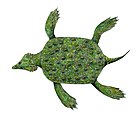短颈龙属
外观
(重定向自短颈龙)
| 短颈龙属 化石时期:
| |
|---|---|

| |
| 企图捕抓黄昏鸟的短颈龙 | |
| 科学分类 | |
| 界: | 动物界 Animalia |
| 门: | 脊索动物门 Chordata |
| 纲: | 爬行纲 Reptilia |
| 目: | †蛇颈龙目 Plesiosauria |
| 科: | †上龙科 Pliosauridae |
| 演化支: | †海猎龙类 Thalassophonea |
| 亚科: | †短颈龙亚科 Brachaucheninae |
| 属: | †短颈龙属 Brachauchenius Williston, 1903[1] |
| 模式种 | |
| Brachauchenius lucasi Williston, 1903[1]
| |
短颈龙属(属名:Brachauchenius)是种上龙类,生存于白垩纪的美国与哥伦比亚,约9000万年前。短颈龙是已知北美洲最后出现的上龙类,估计身长约6至9米。
模式种是B. lucasi,生存于北美洲西部内陆海道,年代为白垩纪土仑阶,约9350万到8930万年前。一个年代较古老的标本,发现于哥伦比亚的巴列姆阶;在非菱龙科的上龙类中,巴列姆阶与欧特里夫阶之间有个化石纪录的断层,短颈龙是断层后第一个出现的非菱龙科的上龙类[2]。
模式标本(编号USNM 4989)是由查尔斯·斯腾伯格(Charles H. Sternberg)在1884年发现于堪萨斯州渥太华县[3][4]。头颅骨长度约90公分。
短颈龙是由塞缪尔·温德尔·威利斯顿(S.W. Williston)在1907年命名[1][5]。在1952年,乔治·史登柏格(George F. Sternberg)在堪萨斯州拉塞尔县的Fairport黏土层,发现一个更大的标本(编号FHSM VP-321),头骨长度为1.7米,由肯尼思·卡彭特(K. Carpenter)叙述[6]。在2005年,两位科学家鉴定出这两个堪萨斯州标本的地质年代[7]。短颈龙的头骨长度为90公分,身长约10公呎。短颈龙是已知北美洲最晚出现的上龙类。
参考资料
[编辑]- ^ 1.0 1.1 1.2 Williston SW. 1903. North American plesiosaurs. Field Columbian Museum, Pub. 73, Geological Series 2 (1):1-79. (29 plates)
- ^ Hampe O. 2005. Considerations on a Brachauchenius skeleton (Pliosauroidea) from the lower Paja Formation (late Barremian) of Villa de Leyva area (Colombia). Fossil Record - Mitteilungen aus dem Museum für Naturkunde in Berlin 8 (1): 37-51.
- ^ Everhart MJ. 2005. Oceans of Kansas - A Natural History of the Western Interior Sea. Indiana University Press, 320 pp. ISBN 780253345479 }}.
- ^ Everhart MJ. 2007. Historical note on the 1884 discovery of Brachauchenius lucasi (Plesiosauria; Pliosauridae) in Ottawa County, Kansas. Kansas Academy of Science, Transactions 110 (3/4): 255-258.
- ^ Williston SW. 1907. The skull of Brachauchenius, with special observations on the relationships of the plesiosaurs. United States National Museum Proceedings 32: 477-489. (pls. 34-37)
- ^ Carpenter K. 1996. A Review of short-necked plesiosaurs from the Cretaceous of the western interior, North America. Neues Jahbruch für Geol. Palaont. Abh. (Stuttgart) 201 (2): 259-287.
- ^ Schumacher BA, Everhart MJ. 2005. A stratigraphic and taxonomic review of plesiosaurs from the old “Fort Benton Group” of central Kansas: A new assessment of old records. Paludicola 5 (2): 33-54.







